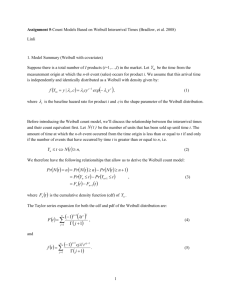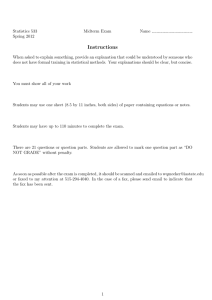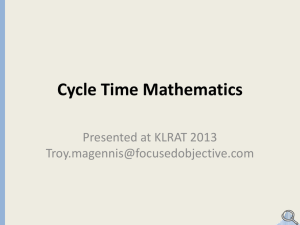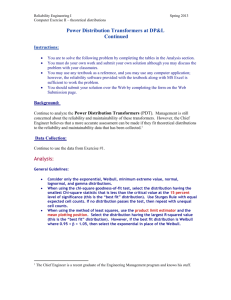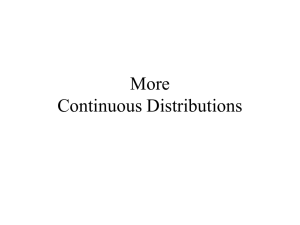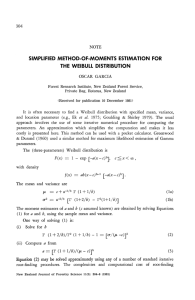Hindawi Publishing Corporation Journal of Applied Mathematics and Decision Sciences
advertisement
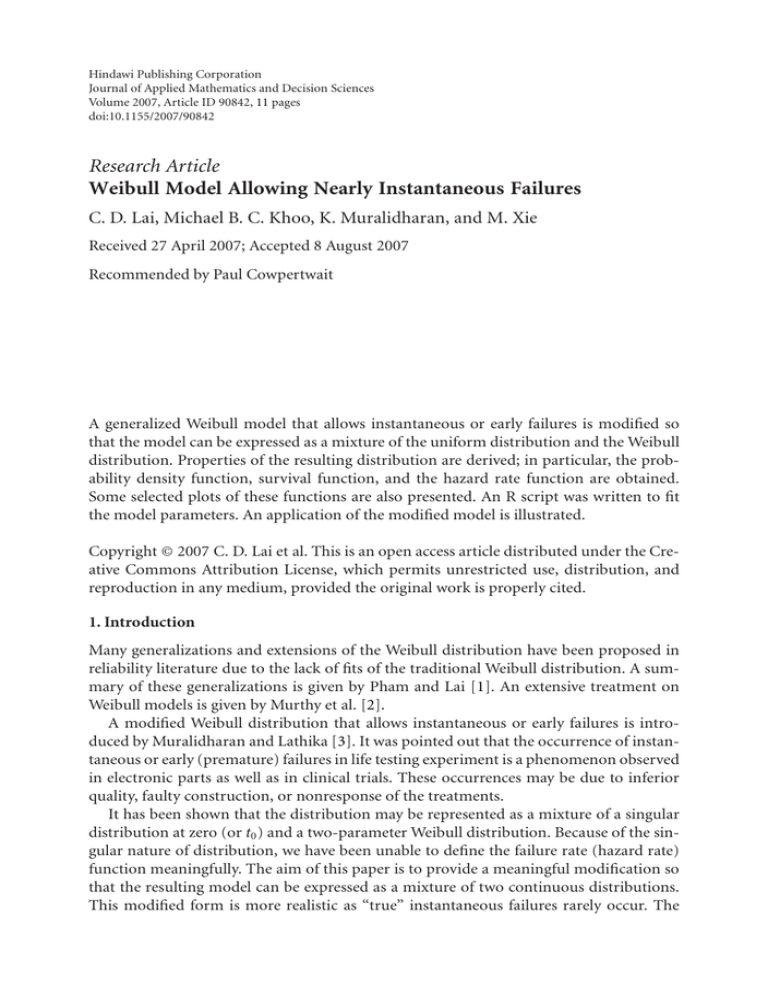
Hindawi Publishing Corporation
Journal of Applied Mathematics and Decision Sciences
Volume 2007, Article ID 90842, 11 pages
doi:10.1155/2007/90842
Research Article
Weibull Model Allowing Nearly Instantaneous Failures
C. D. Lai, Michael B. C. Khoo, K. Muralidharan, and M. Xie
Received 27 April 2007; Accepted 8 August 2007
Recommended by Paul Cowpertwait
A generalized Weibull model that allows instantaneous or early failures is modified so
that the model can be expressed as a mixture of the uniform distribution and the Weibull
distribution. Properties of the resulting distribution are derived; in particular, the probability density function, survival function, and the hazard rate function are obtained.
Some selected plots of these functions are also presented. An R script was written to fit
the model parameters. An application of the modified model is illustrated.
Copyright © 2007 C. D. Lai et al. This is an open access article distributed under the Creative Commons Attribution License, which permits unrestricted use, distribution, and
reproduction in any medium, provided the original work is properly cited.
1. Introduction
Many generalizations and extensions of the Weibull distribution have been proposed in
reliability literature due to the lack of fits of the traditional Weibull distribution. A summary of these generalizations is given by Pham and Lai [1]. An extensive treatment on
Weibull models is given by Murthy et al. [2].
A modified Weibull distribution that allows instantaneous or early failures is introduced by Muralidharan and Lathika [3]. It was pointed out that the occurrence of instantaneous or early (premature) failures in life testing experiment is a phenomenon observed
in electronic parts as well as in clinical trials. These occurrences may be due to inferior
quality, faulty construction, or nonresponse of the treatments.
It has been shown that the distribution may be represented as a mixture of a singular
distribution at zero (or t0 ) and a two-parameter Weibull distribution. Because of the singular nature of distribution, we have been unable to define the failure rate (hazard rate)
function meaningfully. The aim of this paper is to provide a meaningful modification so
that the resulting model can be expressed as a mixture of two continuous distributions.
This modified form is more realistic as “true” instantaneous failures rarely occur. The
2
Journal of Applied Mathematics and Decision Sciences
modification allows us to establish and study the failure rate function of this reliability
model via mixture distributions. We also provide some graphical plots to illustrate some
possible shapes for the survival functions as well as the failure rate functions.
The present paper focuses on the “nearly instantaneous” failure case as it has fewer
parameters. This special case is more realistic than the “early failure” case since many
products exhibit an “infant mortality” phenomenon due to initial defects.
2. Representation of the model
Let F(t) and R(t) = 1 − F(t) denote the cumulative distribution function and the survival
function of the mixture, respectively. We assume that F is continuous and its density be
given by f (t) = F (t). The component distribution functions and their survival functions
are Fi (t) and Ri (t) = 1 − Fi (t), respectively, i = 1,2. The failure rate of a lifetime distribution is defined as h(t) = f (t)/R(t) provided the density exists.
Instead of assuming an instant or an early failure to occur at a particular time point, as
in the original model of Muralidharan and Lathika [3], we now represent this model as a
mixture of a generalized Dirac delta function and the 2-parameter Weibull as opposed to
a mixture of a singular distribution with a Weibull. Thus, the resulting modification gives
rise to a density function:
f (t) = pδd t − t0 + qαλα t α−1 e−(λt) ,
α
p + q = 1, 0 < p < 1,
(2.1)
where
⎧
1
⎪
⎪
⎨ ,
δd t − t0 = ⎪ d
⎪
⎩0,
t0 ≤ t ≤ t0 + d,
(2.2)
otherwise,
for sufficiently small d. Here p > 0 is the mixing proportion.
We note that
δ x − x0 = lim δd x − x0 ,
d→0
(2.3)
where δ(·) is the Dirac delta function. We may view the Dirac delta function as a normal
distribution having a zero mean and standard deviation that tends to 0. For a fixed value
of d, (2.2) denotes a uniform distribution over an interval [t0 ,t0 + d] so the modified
model is now effectively a mixture of a Weibull with a uniform distribution. Instead of
including a possible instantaneous failure in the model, (2.2) allows for a possible “near
instantaneous” failure to occur uniformly over a very small time interval.
/ 0 (but
Note that the case t0 = 0 corresponds to instantaneous failures, whereas t0 =
small) corresponds to the case with early failures.
Noting from (2.1) and (2.2), we see that the mixture density function is not continuous
at t0 and t0 + d. However, both the distribution and survival functions are continuous.
α
Writing f1 (t) = δd (t − t0 ) and f2 (t) = αλα t α−1 e−(λt) , α,λ > 0; (2.1) can be written as
f (t) = p f1 (t) + q f2 (t),
p + q = 1, 0 < p < 1,
(2.4)
C. D. Lai et al. 3
so
F(t) = pF1 (t) + qF2 (t),
(2.5)
R(t) = 1 − F(t) = p + q − pF1 (t) + qF2 (t) = pR1 (t) + qR2 (t).
(2.6)
Thus, the failure (hazard) rate function of the mixture distribution is
h(t) =
p f1 (t) + q f2 (t)
.
pR1 (t) + qR2 (t)
(2.7)
A mixture distribution involving two 2-parameter Weibull distributions has been thoroughly studied in Jiang and Murthy [4]. The mixture considered in this paper is more
complex in the sense that one of the mixing distributions has a finite range which poses
some challenges.
Via (2.4) simulated observations from this model are made by generating uniform
variates and Weibull variates with proportions p and q = 1 − p, respectively.
3. Survival function and failure rate function of the model
Recently, failure rates of mixtures are discussed quite extensively. Lai and Xie [5, Section 2.8] provide a good summary. As demonstrated by Block et al. [6], various shapes
of failure rate functions can arise with a mixture of two increasing failure rate distributions. Now, a Weibull has an increasing (decreasing) failure rate if its shape parameter α
is greater (smaller) than 1. The uniform distribution also has an increasing failure rate if
it is uniform over [0, a]. Thus we are interested to know what shapes would result from
our model.
The reliability (survival) functions of the respective component distributions are given
by
⎧
⎪
⎪
⎪1
⎪
⎪
⎨
if 0 ≤ t < t0 ,
R1 (t) = ⎪ d + t0 − t
⎪
d
⎪
⎪
⎪
⎩0
if t0 ≤ t ≤ t0 + d,
(3.1)
if t > t0 + d,
R2 (t) = e−(λt) ,
α
t ≥ 0, α,λ > 0.
(3.2)
The failure rates are, respectively,
⎧
⎪
0,
⎪
⎪
⎪
⎪
⎨
h1 (t) = ⎪
0 ≤ t < t0 ,
1
⎪
d + t0 − t
⎪
⎪
⎪
⎩∞,
,
t0 ≤ t ≤ t0 + d,
(3.3)
t > t0 + d,
h2 (t) = αλ(λt)α−1 .
(3.4)
4
Journal of Applied Mathematics and Decision Sciences
It can be shown from (2.4) and (2.6) that for any mixture of two continuous distributions, the failure rate function can be expressed as
h(t) =
f (t)
= w(t)h1 (t) + 1 − w(t) h2 (t),
R(t)
(3.5)
where w(t) = pR1 (t)/R(t) for all t ≥ 0. In our case,
⎧ p
⎪
⎪
⎪
⎪
⎪
R(t)
⎪
⎪
⎨
if 0 ≤ t < t0 ,
w(t) = ⎪ pR1 (t)
⎪
⎪
⎪
⎪
⎪ R(t)
⎪
⎩0
(3.6)
if 0 ≤ t ≤ t0 + d,
if t > t0 + d
with
w (t) = w(t) 1 − w(t) h2 (t) − h1 (t) .
(3.7)
(Note that equation (3.7) is valid for all cases).
Also a simple differentiation shows that
h (t) = w (t)h1 (t) + w(t)h1 (t) − w (t)h2 (t) + [1 − w(t)]h2 (t).
(3.8)
Now, w(t)h1 (t) = pR1 (t)/R(t) × f1 (t)/R1 (t) = p f1 (t)/R(t), so (3.5) is well defined for
all t > 0.
Summarized expression for R(t) and h(t) are, respectively, given as
⎧
α
⎪
⎪
p + qe−(λt) ,
⎪
⎪
⎪
⎪
⎪
⎨ R(t) = pR1 (t) + qR2 (t) = ⎪ p d + t0 − t + qe−(λt)α ,
⎪
d
⎪
⎪
⎪
⎪
⎪ −(λt)α
⎩
qe
,
⎧
α
qe−(λt)
⎪
⎪
⎪
αλα t α−1 ,
⎪
⎪
−(λt)α
⎪
p
+
qe
⎪
⎪
⎪
⎨
α
−(λt)
α α −1
h(t) = ⎪ p + dqe αλ t
,
⎪
−(λt)α
⎪
⎪
⎪ p d + t0 − t + dqe
⎪
⎪
⎪
⎪
⎩αλα t α−1 ,
0 ≤ t < t0 ,
t0 ≤ t ≤ t0 + d,
(3.9)
t > t0 + d,
0 ≤ t < t0 ,
t0 ≤ t ≤ t0 + d,
(3.10)
t > t0 + d.
Recall that h(t) is discontinuous at both t = t0 and t = t0 + d. Unlike the model of Muralidharan and Lathika [3], the survival function is continuous though not differentiable
at t = t0 and t = t0 + d.
C. D. Lai et al. 5
0.5
f (t)
0.4
0.3
0.2
0.1
1
2
3
4
5
6
7
t
p = 0.2
p = 0.5
p = 0.8
Figure 4.1. Plot of f (t) : λ = 1,α = 0.5,d = 0.2,t0 = 0.
4. Nearly instantaneous failure case (t0 = 0)
Consider a special case of the model (2.1) whereby t0 = 0. The model may be called the
Weibull with “nearly instantaneous failure” model.
In this case, (3.3) is simplified giving the failure rate of the uniform distribution as
⎧
1
⎪
⎨
,
d
−
t
h1 (t) = ⎪
⎩∞,
0 ≤ t ≤ d,
(4.1)
t > d,
and (3.1) its survival function is given as
⎧
⎪
⎨d −t
R1 (t) = ⎪ d
⎩0
if 0 ≤ t ≤ d,
(4.2)
if t > d.
The Weibull model with “nearly instantaneous failure” occurring uniformly over [0,d]
has
⎧
p(d − t)
α
⎪
⎪
⎨
+ qe−(λt) ,
0 ≤ t ≤ d,
⎪
⎩qe−(λt)α ,
t > d,
R(t) = ⎪
d
⎧
α
p + dqe−(λt) αλα t α−1
⎪
⎪
⎨
,
−(λt)α
h(t) = ⎪ p(d − t) + dqe
⎪
⎩ α α −1
αλ t
,
0 ≤ t ≤ d,
(4.3)
(4.4)
t > d.
Graphs of Survival, Density, and Failure Rate Functions. Graphical plots are important for
ageing distributions. It is not the aim of this paper to present complete characterizations
6
Journal of Applied Mathematics and Decision Sciences
0.8
0.7
0.6
f (t)
0.5
0.4
0.3
0.2
0.1
1
2
3
4
5
6
7
t
p = 0.2
p = 0.5
p = 0.8
Figure 4.2. Plot of f (t) : λ = 1,α = 2,d = 0.2,t0 = 0.
0.8
0.7
R(t)
0.6
0.5
0.4
0.3
0.2
0.1
2.5
5
7.5
10
t
12.5
15
17.5
20
p = 0.2
p = 0.5
p = 0.8
Figure 4.3. Plot of R(t) : λ = 1,α = 0.5,d = 0.2,t0 = 0.
for the survival, density, and the failure rate functions. Instead, snapshots are taken of
some possible shapes from this model, as it is important to identify whether the model is
useful for specific datasets for which empirical plots are available.
Consider in detail the special case when t0 = 0, that is, the Weibull with “nearly” instantaneous failure model.
Density functions. In both Figures 4.1 and 4.2, three density functions with p = 0.2, 0.5,
and 0.8 are plotted. In all figures, the smallest mixing proportion p is given by the solid
line.
C. D. Lai et al. 7
1
0.8
R(t)
0.6
0.4
0.2
2.5
5
7.5
10
t
12.5
15
17.5
20
p = 0.2
p = 0.5
p = 0.8
Figure 4.4. Plot of R(t) : λ = 1,α = 2,d = 0.2,t0 = 0.
h(t) : α = 0.5, d = 0.5, p = 0.3
Failure rate function
Failure rate function
h(t) : α = 0.5, d = 0.5, p = 0.08
5
4
3
2
1
0
0.25
0.5
t
0.75
1
4
3
2
1
0
0
0.25
2
1.5
1
0.5
0
0.25
0.5
t
0.75
0.75
1
h(t) : α = 3, d = 0.1, p = 0.5
2.5
Failure rate function
Failure rate function
h(t) : α = 2.5, d = 0.5, p = 0.08
0.5
t
1
10
7.5
5
2.5
0
0
0.4
0.8
t
1.2
1.6
Figure 4.5. Plots of failure rate functions.
Survival functions. The survival functions are given by Figures 4.3 and 4.4 which correspond to the density functions in Figures 4.1 and 4.2, respectively.
Failure rate functions. The failure rate function h(t) is given as in (4.4). Clearly, its shape
is the same as the Weibull failure rate after d. Thus we focus on the segment from 0 to d.
8
Journal of Applied Mathematics and Decision Sciences
Table 5.1. Instantaneous failures at ti = 0, i = 1,2,... ,28.
Estimates
Standard error
p̂
0.6999992
0.07244318
α̂
1.1929632
0.28878116
1/ λ̂
0.9315360
0.23615878
Since the scale parameter λ does not alter the shape, it is set to one. Figure 4.5 shows that
h(t) can be increasing, decreasing, or bathtub shaped for 0 ≤ t ≤ d.
From the plots, it can be seen that the failure rate function of the model gives rise
to several different shapes and bumps; this is expected as mixing distributions with a
component distribution that has a finite range often cause some problems. Although the
second part can be either increasing or decreasing, the first segment can achieve various
shapes. This finding is consistent with Block et al. [6].
5. Data fitting and an application
Mixture distributions are used widely in the statistics literature. Bebbington et al. [7] have
used a mixture of two generalized Weibull distributions to fit human mortality data. A
mixture distribution may give rise to different failure rate thus it can provide pseudodemarcation of various phases of a lifespan. Bebbington et al. [7] also use their mixture
distribution to identify the differences between (sub)populations.
While software for fitting mixture distributions is available, such as the MIX package
for the R environment (Macdonald [8]), such packages do not handle uniform distributions, or mixtures of unlike distributions.
To fit the model to a dataset, an R script was written. One can write a code in R to fit
all 4 parameters (p,λ,α,d) and another to fit 3 parameters (p,λ,α) with d given and held
fixed. The second case always works, and works very well, but the first never gives good
results when the edge of the uniform (parameter d) is inside the peak of the Weibull (personal communication with Professor Macdonald). This is because there is not enough
information in the data to fit the 4th parameter in this situation. In practice, the value of
d can be manually estimated quite accurately from the dataset.
5.1. Application. A sample of 40 boards of woods were checked for their dryness on
a particular area of a board. The actual observations were degrees of dryness measured
as a percentage. This dataset was analysed in Muralidharan and Lathika [3] with ti = 0,
i = 1,2,...,28 and the other positive observations are as follows: 0.0463741, 0.0894855,
0.4, 0.42517, 0.623441, 0.6491, 0.73346, 1.35851, 1.77112, 1.86047, 2.12125, 2.12389.
Treating the degree of dryness as the “failure time,” we apply the Weibull model with
“nearly instantaneous” failures model to this data (see Table 5.1).
It is reasonable to spread the zeros uniformly over an interval [0,d). For illustration,
we select d = 0.135 so that t1 = 0, t2 = 0.0005, t3 = 0.001,...,t28 = 0.0135. Applying the
MLE method in R, we found the following see Table 5.2.
It seems to us the sizes of standard errors of the three estimates are reasonable in view
of a small sample size.
C. D. Lai et al. 9
Table 5.2. Uniform spread of “nearly” instantaneous failure times.
Estimates
Standard error
p̂
0.6981846
0.07292797
α̂
1.1656527
0.30176818
1/ λ̂
0.9431262
0.24822803
Table 5.3. Exponential with “nearly” instantaneous failures: d = 0.0135.
v1–estimates (se)
v2–estimates (se)
p̂
0.6959071 (0.0734413)
0.6959356 (0.07343414)
1/ λ̂
1.0031716 (0.2896755)
1.0033558 (0.28970177)
Since the shape parameter α̂ = 1.16 and the fact that three parameters are being estimated from few data points, it would be more realistic to specify α = 1 a priori (i.e., an
exponential) as a special case of the Weibull model. This would reduce the number of parameters and therefore the uncertainty in the parameter estimates. Table 5.3 summarizes
the parameter estimates of the exponential mixing with the uniform model.
Note. v1 consists of of measurements from the original dataset. The 28 zeros in v1 are
then calibrated to spread over uniformly over [0,d]. v2 is formed by replacing the first 28
cells of v1 by the calibrated values.
We note from the preceding table that the precision for the second parameter estimate
actually deteriorates in comparison with the Weibull case. Perhaps the Akaike information criteria (AIC) or BIC would be a more objective way to evaluate this comparison.
5.2. Sensitivity analysis. In the above model fitting, we have chosen d manually and the
value d = 0.0135 is chosen because it is sufficiently apart from the first nonzero observed
value 0.0463741. We have assessed the sensitivity of the selection of the parameter d. For
the “instantaneous” failures case, we let d vary between 0.01 and 0.04; the resulting estimates and their standard errors are virtually unchanged. However, it becomes sensitive
when d is too close to t = 0 or to the first Weibull failure time t = 0.0463741. If d is set
to 0.135, the parameter estimates are then given by p̂ = 0.7497827, α̂ = 1.8827550, and
1/ λ̂ = 0.7327841 indicating that these estimates change noticeably as d encroaches on the
Weibull “territory.” It also shows that for this value of d, the model with the uniform mixing with the exponential can longer be an alternative because the estimate for the shape
parameter α is now close to 2.
6. Conclusion
The Weibull distribution has been widely used as a life model in reliability applications.
However, one often finds that it does not fit well in the early part of a lifespan for various
reasons. In particular, in the cases where initial defects are present causing early failures,
the Weibull distribution is found inadequate to model such phenomenon. The proposed
model of a modified Weibull mixing with a uniform distribution to model the first phase
of a lifespan should provide a useful alternative.
10
Journal of Applied Mathematics and Decision Sciences
Appendix
R code for fitting the model
v1<-rep(0,40)
v1[29:40]<-c(0.0463741,0.0894855,0.4,0.42517,0.623441,0.6491,
0.73346,1.35851,1.77112,1.86047,2.12125,2.12389)
v2 <- c(0, 0.0005, 0.001, 0.0015, 0.002, 0.0025, 0.003, 0.0035,
0.004, 0.0045, 0.005, 0.0055, 0.006, 0.0065, 0.007, 0.0075, 0.008,
0.0085, 0.009, 0.0095, 0.01, 0.0105, 0.011, 0.0115, 0.012, 0.0125,
0.013, 0.0135, 0.046374, 0.089486, 0.4, 0.42517, 0.623441, 0.6491,
0.73346, 1.35851, 1.77112, 1.86047, 2.12125, 2.12389)
uniweib <-cbind(v1, v2)
neglluniweib<-function(p,x,d){
pp<-p[1]
shape<-p[2]
rate<-p[3]
if(pp>0 & shape>0 & rate>0 & pp<1) {
-sum(log(pp*dunif(x,0,d)+(1- pp)*dweibull(x,shape,1/rate)))
}else{
1e+200
}
}
uniweibmle <- function(d,prop,shape,rate,x) {
p<-c(prop,shape,rate)
fit<-nlm(neglluniweib,p=p,x=x,d=d,hessian=T)
fit$se<-sqrt(diag(solve(fit$hessian)))
fit[c(1,2,7,3,4,5,6)]
}
uniweibmle(0.0135,0.1,2,1,v1) uniweibmle(0.0135,0.1,2,1,v2)
Acknowledgments
The first author is privileged to have been a former student and a colleague of Professor
Jeff Hunter, who has been an inspiration to many. The authors wish him well in his retirement. The authors are very grateful to Professor Peter Macdonald who helped them
to write an R script for the model and to the referees for their helpful comments. The
authors also wish to acknowledge Dr. K. Govindaraju for his help to improve the quality
of the figures.
C. D. Lai et al.
11
References
[1] H. Pham and C. D. Lai, “On recent generalizations of the Weibull distribution,” IEEE Transactions on Reliability, vol. 54, no. 3, pp. 454–458, 2007.
[2] D. N. P. Murthy, M. Xie, and R. Jiang, Weibull Models, Wiley Series in Probability and Statistics,
John Wiley & Sons, Hoboken, NJ, USA, 2004.
[3] K. Muralidharan and P. Lathika, “Analysis of instantaneous and early failures in Weibull distribution,” Metrika, vol. 64, no. 3, pp. 305–316, 2006.
[4] R. Jiang and D. N. P. Murthy, “Mixture of Weibull distributions—parametric characterization
of failure rate function,” Applied Stochastic Models and Data Analysis, vol. 14, no. 1, pp. 47–65,
1998.
[5] C. D. Lai and M. Xie, Stochastic Ageing and Dependence for Reliability, Springer, New York, NY,
USA, 2006.
[6] H. W. Block, Y. Li, and T. H. Savits, “Initial and final behaviour of failure rate functions for
mixtures and systems,” Journal of Applied Probability, vol. 40, no. 3, pp. 721–740, 2003.
[7] M. Bebbington, C. D. Lai, and R. Zitikis, “Modeling human mortality using mixtures of bathtub
shaped failure distributions,” Journal of Theoretical Biology, vol. 245, no. 3, pp. 528–538, 2007.
[8] P. D. M. Macdonald, “MIX for the R Environment,” distributed by ICHTHUS DATA SYSTEMS,
http://www.math.mcmaster.ca/peter/mix/mix.html.
C. D. Lai: Institute of Information Sciences and Technology, Massey University,
Palmerston North, New Zealand
Email address: c.lai@massey.ac.nz
Michael B. C. Khoo: School of Mathematical Sciences, Universiti Sains Malaysia,
11800 Pulau Pinang, Malaysia
Email address: mkbc@usm.my
K. Muralidharan: Department of Statistics, The Maharaja Sayajirao University of Baroda,
Vadodara 390 002, India
Email address: lmv murali@yahoo.com
M. Xie: Department of Industrial and Systems Engineering, National University of Singapore,
Singapore 119077
Email address: mxie@nus.edu.sg
